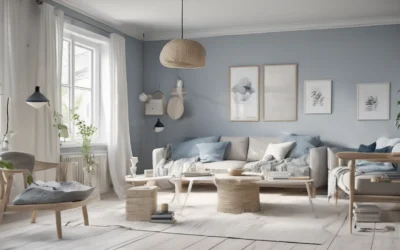
Imagine a living space that whispers tranquility, where every piece serves a purpose, and aesthetic beauty thrives in simplicity. Welcome to the world of Japandi style—a captivating design approach merging Japanese and Scandinavian influences. Based on simplicity and functionality, this aesthetic perfectly complements modern minimalism, creating a serene atmosphere ideal for today’s hectic lives. In this article, you’ll discover the principles of Japandi design, how to incorporate them into your home, and the subtle differences that make this style uniquely appealing.
What exactly will you learn? We’ll delve into practical tips for merging these two styles, how to curate your space for maximum effect, and inspiring ideas to elevate your home. Whether you’re redecorating an entire room or just need a few fresh ideas, this guide is your roadmap to a harmonious living space.
Here’s what to expect in the upcoming sections:
- Understanding Japandi Style
- Key Principles of Modern Minimalism
- How to Merge Japandi and Minimalism
- Practical Examples and Tips
- Creating a Cohesive Space
- FAQs about Japandi and Minimalism
Understanding Japandi Style
Japandi style harmonizes the warm, inviting aesthetics of Scandinavian design with the elegant, minimalistic principles of Japanese interiors. The result is a style that is both functional and beautiful.
Origins and Influences
The roots of Japandi can be traced back to the early 20th century when designers in both regions began to emphasize simplicity, natural materials, and a close relationship to nature. This intentional stylistic connection goes beyond mere aesthetics; it embodies a lifestyle focused on mindfulness and well-being.
Characteristics of Japandi Design
- Natural Materials: Wood, bamboo, and stone are commonly used to create warmth.
- Neutral Color Palette: Soft earthy tones dominate, combining light hues with rich dark colors.
- Functionality: Every piece of furniture serves a purpose, merging beauty with utility.
Key Principles of Modern Minimalism
Modern minimalism strives to eliminate clutter and emphasize simplicity and essential form. Its key principles are crucial to understanding how it complements Japandi style.
Minimalism Defined
Minimalism is about reducing excess and prioritizing the essential. It focuses on clean lines, open spaces, and fewer possessions, allowing for a greater appreciation of what remains.
The Essence of Functionality
Minimalism emphasizes functional design. Each item in a minimalist space should have a distinct purpose and contribute to the overall harmony of the home.
How to Merge Japandi and Minimalism
Merging Japandi with modern minimalist elements requires a thoughtful approach.
Choose a Cohesive Color Palette
Both styles favor neutral colors; therefore, a cohesive palette of whites, greys, and earthy tones helps tie spaces together.
Incorporate Natural Textures
Adding textures like wood, stone, or fibers not only enhances aesthetic appeal but also brings warmth and life to minimalist spaces.
Prioritize Quality over Quantity
Invest in fewer, high-quality pieces that embody the principles of both styles. This approach fosters a more tranquil environment.
Practical Examples and Tips
Let’s dive into actionable insights that can help you incorporate this combined aesthetic into your home.
Selecting Furniture
Opt for furniture with clean lines and modest forms. Look for handcrafted pieces that echo the craftsmanship found in both Japanese and Scandinavian designs.
Decorative Accents
Use decor sparingly. Incorporate plants, ceramics, and textiles to reflect warmth while retaining an uncluttered aesthetic.
Creating a Cohesive Space
To achieve a harmonious environment, each element must work together seamlessly.
Flow of Spaces
Design spaces that encourage movement and connection, ensuring a smooth transition from room to room.
Lighting and Ambiance
Natural light is essential. Use sheer curtains to enhance daylight and capture the essence of tranquility.
FAQs about Japandi and Minimalism
What is the main difference between Japandi and modern minimalism?
Japandi focuses on combining Japanese simplicity with Scandinavian warmth, while modern minimalism emphasizes a more clinical and less personalized approach to space.
How can I incorporate Japandi elements in a small space?
Use multifunctional furniture, a light color palette, and fewer decorative items to maximize visual space and maintain a serene atmosphere.
Is Japandi style suitable for all types of homes?
Yes! Japandi can be adapted to various architectural styles, creating a calm and inviting atmosphere in any space.
What types of materials are preferred in Japandi design?
Natural materials like wood, bamboo, and linen are favored for their tactile qualities and sustainability, enhancing the organic feel of the space.
Can I mix Japandi style with other design aesthetics?
Certainly! Japandi’s focus on simplicity and functionality allows it to blend well with other styles, provided harmony and balance are maintained.
Conclusion & Next Steps
Incorporating Japandi style into your space not only enhances the aesthetic but also contributes to a sense of peace and mindfulness amidst the chaos of everyday life. By embracing the principles of both Japandi and modern minimalism, you’re not just decorating a space; you’re curating a sanctuary that reflects your personal ethos. Start today by evaluating your space and choosing key elements that resonate with this beautifully balanced aesthetic.
Interested in more home design tips? Check out our articles on Scandinavian decor, minimalist home essentials, and how to create a calming space.
Content Disclaimer
Information provided in this article is for educational purposes only. Consult professionals for specific advice tailored to your situation.
Categories
- Accent Walls & Ceilings (61)
- Art Curation & Gallery (62)
- Bedding Style Trends (68)
- Bedroom Makeover (81)
- Bohemian & Eclectic Styles (58)
- DIY & Budget-Friendly Decor (64)
- Eco-Friendly Design (62)
- Furniture Care (71)
- Home Decor & Design Ideas (163)
- Home Wellness Spaces (59)
- Integrated Outdoor Living (67)
- Japandi Style (61)
- Kids and Nursery Decor (59)
- Living Room Decor (79)
- Mix & Match Techniques (73)
- Modern & Contemporary Design (66)
- Rug Sizing & Placement (73)
- Scandinavian Design Inspiration (19)
- Seasonal Home Decor (80)
- Small Space Solutions (73)
- Wall Art & Painting Tips (77)
Recent Comments
Archives
Product Gallery
-
Large Area Green Rugs for Bedroom Nordic Living Room Decoration Shaped Carpet Irregular Plush Lounge Rug Home Thick Washable Mat
Rated 5.00 out of 5$36.00 – $225.00Price range: $36.00 through $225.00 -
Nordic Style Rugs for Bedroom Morandi Living Room Decoration Carpet Large Area Geometry Lounge Rug Home Cloakroom Non-slip Mat
Rated 5.00 out of 5$26.00 – $387.00Price range: $26.00 through $387.00 -
Irregular Shapes Living Room Decoration Carpet Modern Style Rugs for Bedroom Home Thicken Plush Rug Fluffy Soft Lounge Floor Mat
Rated 4.85 out of 5$37.00 – $225.00Price range: $37.00 through $225.00














